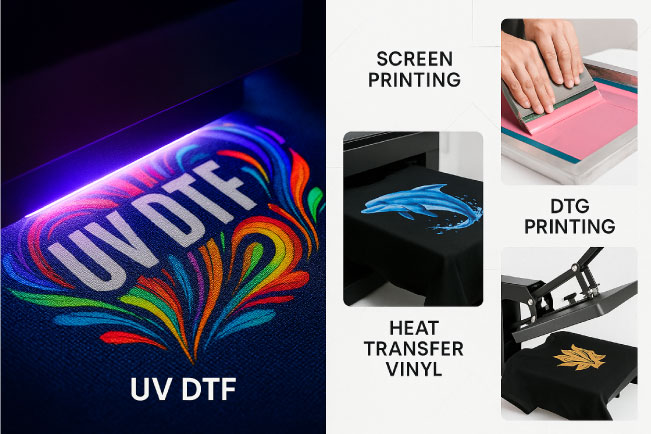In the ever-evolving world of garment and product printing, choosing the right printing method can make all the difference in quality, cost, and durability. Among the latest advancements, UV DTF transfer has emerged as a powerful contender, promising unmatched vibrancy and longevity. But how does UV DTF transfer compare to other common techniques such as traditional DTF, screen printing, direct-to-garment (DTG), heat transfer vinyl (HTV), and sublimation? This comprehensive guide will break down the key differences, benefits, and limitations of each method to help you decide the best fit for your printing needs in 2025.
What is UV DTF Transfer?
Before diving into comparisons, let’s clarify what UV DTF transfer actually means. UV DTF stands for Ultraviolet Direct to Film transfer. It is a specialized form of DTF printing where UV-cured inks are printed directly onto a special transfer film. The ink is cured instantly under UV light, creating a durable, vibrant print that can then be heat-pressed onto garments or other substrates.
This technology combines the benefits of traditional DTF (Direct to Film) printing with the superior curing and durability offered by UV inks. UV DTF transfers are known for their brilliant colors, flexibility, and excellent adhesion on a variety of fabrics.
How Does UV DTF Transfer Work?
- Printing: UV inks are printed directly onto a PET or similar transfer film using a UV inkjet printer.
- Curing: The printed film passes under UV lamps, instantly curing the ink, which creates a solid, durable layer.
- Powdering: A special adhesive powder is applied to the cured ink layer to help with adhesion during heat transfer.
- Heat Pressing: The transfer film is heat pressed onto the fabric or substrate, bonding the ink permanently.
- Peeling: After cooling, the transfer film is peeled off, leaving the vibrant design on the garment.
This process results in a highly durable and colorful print that resists cracking, fading, and peeling even after multiple washes.
UV DTF Transfer vs Traditional DTF Printing
Traditional DTF printing uses plastisol-based or water-based inks printed on film, which is then heat-pressed onto garments. While effective, traditional DTF ink curing relies on heat or time to dry, which can sometimes impact print quality and durability.
Key Differences:
- Ink Type and Curing: UV DTF uses UV-cured inks, which dry instantly under UV light. Traditional DTF inks need heat or air drying.
- Durability: UV DTF prints tend to be more durable, with better resistance to cracking and fading due to the solid curing process.
- Color Vibrancy: UV inks offer superior color vibrancy and sharper details.
- Environmental Impact: UV curing is a cleaner process with less volatile organic compounds (VOCs) released compared to traditional ink drying.
Which is Better?
For businesses seeking vibrant, long-lasting prints with quicker production times, UV DTF transfer is a superior choice. However, traditional DTF remains popular for budget-conscious projects.
UV DTF Transfer vs Screen Printing
Screen printing is one of the oldest and most popular garment printing methods, known for its bold, long-lasting prints, especially on large volume orders.
Key Differences:
- Setup Time: Screen printing requires creating screens for each color, making it time-consuming for small batches. UV DTF requires no screens, allowing quick setup for small or customized runs.
- Color Range: UV DTF offers a broader color spectrum and photographic-quality prints. Screen printing is limited to solid colors unless expensive CMYK processes are used.
- Texture: Screen prints are thicker with a tactile feel. UV DTF transfers are thinner and softer on garments.
- Durability: Screen printing is highly durable, especially for bulk orders, but UV DTF has caught up due to the tough UV curing process.
- Cost: Screen printing becomes cost-effective with large orders; UV DTF is more cost-efficient for smaller or customized runs.
Which is Better?
For large volume, simple designs, screen printing remains cost-effective and durable. For highly detailed, colorful designs or small batches, UV DTF transfer is more versatile and economical.
UV DTF Transfer vs Direct to Garment (DTG) Printing
DTG printing involves spraying water-based inks directly onto garments, followed by curing with heat. It’s popular for detailed, full-color prints on cotton fabrics.
Key Differences:
- Fabric Compatibility: DTG works best on 100% cotton; UV DTF works well on a variety of fabrics including cotton, polyester, blends, and more.
- Print Feel: DTG ink penetrates fabric fibers for a soft feel, while UV DTF sits on top as a transfer but remains flexible.
- Durability: UV DTF transfers tend to last longer without fading or cracking compared to DTG prints.
- Speed and Maintenance: DTG printers require regular maintenance and pre-treatment; UV DTF printing involves simpler workflow.
- Color Vibrancy: UV DTF offers higher vibrancy and sharpness due to UV curing.
Which is Better?
For high-quality cotton prints with a soft hand, DTG is a great option. For diverse fabrics, durability, and vibrant designs, UV DTF transfer excels.
UV DTF Transfer vs Heat Transfer Vinyl (HTV)
HTV involves cutting vinyl designs which are heat-pressed onto fabric. It is popular for custom names, numbers, and simple graphics.
Key Differences:
- Design Complexity: UV DTF can handle complex, full-color photographic images; HTV is limited to simpler shapes and fewer colors.
- Feel: HTV has a thick, vinyl feel; UV DTF transfers are thin and flexible.
- Durability: Both are durable, but UV DTF transfers tend to resist cracking better over time.
- Production Speed: UV DTF is faster for complex designs; HTV requires vinyl cutting for each design element.
Which is Better?
For colorful, photographic prints, UV DTF transfer is the way to go. For simple, solid color designs or lettering, HTV remains a popular, budget-friendly option.
UV DTF Transfer vs Sublimation Printing
Sublimation printing uses heat to transfer dye into polyester fabrics, resulting in vibrant, permanent prints.
Key Differences:
- Fabric Type: Sublimation works only on polyester or polyester-coated substrates; UV DTF works on cotton, polyester, blends, and more.
- Color Vibrancy: Sublimation produces vibrant, full-color prints that become part of the fabric. UV DTF offers comparable vibrancy on various fabrics.
- Durability: Sublimation prints do not crack or peel as ink becomes part of the fabric. UV DTF prints sit on top but have excellent durability due to UV curing.
- Feel: Sublimation prints have no added layer feel; UV DTF prints add a thin layer but remain flexible.
Which is Better?
For polyester apparel and a no-feel print, sublimation is ideal. For cotton, blends, or multi-fabric applications with vibrant, durable prints, UV DTF transfer is more versatile.
Advantages of UV DTF Transfer in 2025
- Exceptional Print Quality: UV-cured inks deliver brilliant, sharp images with rich colors.
- Fast Production: Instant curing reduces production time and increases throughput.
- Eco-Friendly: UV inks emit fewer VOCs, making it a greener choice.
- Versatility: Compatible with many fabric types and substrates.
- Durability: Resistant to cracking, peeling, and fading even after numerous washes.
- Soft Feel: Thin, flexible prints with minimal texture.
- Low Setup Cost: Ideal for small batches and customization without the need for screens.
Limitations of UV DTF Transfer
- Equipment Cost: UV inkjet printers and UV curing systems can have a higher initial investment.
- Transfer Film Requirement: Unlike DTG, it requires a film transfer step.
- Heat Press Needed: Requires a heat press machine for application.
- Fabric Restrictions: While versatile, certain very dark or highly textured fabrics might affect print adhesion.
When Should You Choose UV DTF Transfer?
- You need vibrant, long-lasting prints with excellent durability.
- Printing on a variety of fabrics beyond just polyester or cotton.
- Small to medium batch runs with custom or photographic designs.
- You want fast turnaround times and lower environmental impact.
- Seeking an alternative to screen printing or DTG that balances cost and quality.
Is UV DTF Transfer the Future of Garment Printing?
The rise of UV DTF transfer marks a new era in garment printing technology. By combining the vibrancy and flexibility of DTF with the instant curing and durability of UV inks, it offers a compelling solution for businesses and creators alike.
Compared to traditional DTF, screen printing, DTG, HTV, and sublimation, UV DTF transfer holds its own by delivering superior color, durability, and versatility. While it may require higher initial investment in equipment, the long-term benefits of faster production, eco-friendliness, and unmatched print quality make it an increasingly popular choice in 2025 and beyond.
For any printing business or custom apparel creator looking to upgrade their process, UV DTF transfer is definitely worth exploring. At DTFSuperPrint.com, we are proud to offer cutting-edge UV DTF transfer solutions that can elevate your custom printing game to the next level.
If you’re ready to experience the best in durable, vibrant custom prints, explore our UV DTF transfer products and services today!

